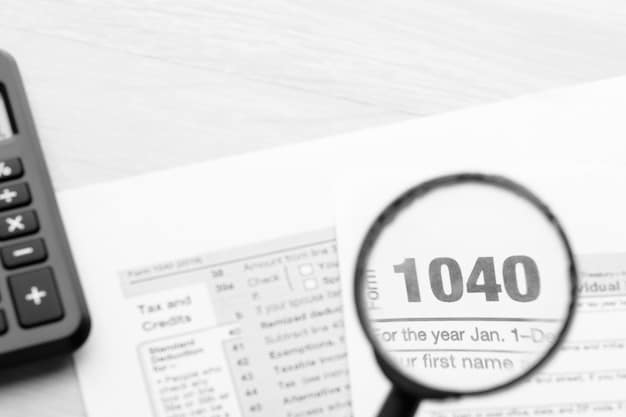Estimated Taxes 2025: A Self-Employed Guide to Avoid Penalties

Estimated taxes are a method used to pay income tax and self-employment tax throughout the year, rather than in one lump sum at the end, helping self-employed individuals avoid penalties by meeting their tax obligations quarterly.
Navigating the world of taxes can be particularly challenging for self-employed individuals. Understanding and paying your estimated taxes: a comprehensive guide for self-employed individuals to avoid penalties in 2025 is crucial to avoid potential penalties and stay compliant with IRS regulations.
Understanding Estimated Taxes
Estimated taxes are the method used to pay Social Security, Medicare, and income taxes when you don’t have taxes withheld from a paycheck. This typically applies to self-employed individuals, freelancers, gig workers, and small business owners who receive income without standard withholding.
Who Needs to Pay Estimated Taxes?
You generally need to pay estimated taxes if you expect to owe at least $1,000 in taxes when you file your tax return. This includes those who are self-employed, partners, and S corporation shareholders.
When Are Estimated Taxes Due?
Estimated taxes are typically due four times a year. Here are the usual deadlines:
- Quarter 1 (January 1 to March 31): Due April 15
- Quarter 2 (April 1 to May 31): Due June 15
- Quarter 3 (June 1 to August 31): Due September 15
- Quarter 4 (September 1 to December 31): Due January 15 of the following year
It’s essential to mark these dates on your calendar to avoid late payment penalties. If any of these dates fall on a weekend or holiday, the deadline is shifted to the next business day.
Paying estimated taxes involves forecasting your income and tax liabilities for the year. Accurate and timely payments ensure you meet your IRS obligations and avoid unnecessary penalties.
Calculating Your Estimated Taxes
Calculating your estimated taxes accurately is crucial to avoid underpayment penalties. The IRS provides a worksheet (Form 1040-ES) to assist you in this process. Here’s a step-by-step approach to calculating what you owe.

Estimating Your Income
Start by estimating your expected gross income for the year. Consider all sources of income, including self-employment earnings, interest, dividends, and any other taxable revenue. Review your income from the previous year as a starting point, but adjust for any anticipated changes.
Calculating Self-Employment Tax
Self-employment tax consists of Social Security and Medicare taxes. You’ll need to calculate your self-employment tax using Schedule SE (Form 1040). The self-employment tax rate is 15.3% (12.4% for Social Security and 2.9% for Medicare) on 92.35% of your self-employment income.
Determining Your Adjusted Gross Income (AGI)
Calculate your AGI by subtracting above-the-line deductions from your gross income. Common deductions include contributions to a traditional IRA, student loan interest payments, and health savings account (HSA) contributions.
Itemized Deductions or Standard Deduction
Decide whether to itemize your deductions or take the standard deduction. Itemizing can lower your tax liability if your itemized deductions exceed the standard deduction. Common itemized deductions include medical expenses, state and local taxes (SALT), and charitable contributions.
- Standard Deduction: Use the standard deduction amount based on your filing status.
- Itemized Deductions: Calculate your itemized deductions and compare the total to the standard deduction to determine which method results in a lower tax liability.
Accurate calculations are essential to estimating your tax liability and avoiding penalties. Regularly review your income and expenses throughout the year to make necessary adjustments to your estimated tax payments.
Methods for Paying Estimated Taxes
The IRS offers several convenient methods for paying your estimated taxes. Choosing the right method can make the process smoother and ensure timely payments.
IRS Direct Pay
IRS Direct Pay is a free service that allows you to pay your taxes directly from your checking or savings account. You can access it on the IRS website and schedule payments in advance. This method is secure and eliminates the need for mailing checks.
Electronic Funds Withdrawal (EFW)
If you file your taxes online using tax preparation software or through a tax professional, you can use Electronic Funds Withdrawal to pay your estimated taxes. This method allows you to debit your bank account when you e-file your return.
Credit or Debit Card
You can pay your estimated taxes using a credit or debit card through a third-party payment processor. Please note that these processors charge a small fee for their services. Ensure you’re comfortable with the fee before proceeding with this option.
Check or Money Order
You can also pay your estimated taxes by mail using a check or money order. Make sure your check or money order is payable to the U.S. Treasury, and include your name, address, phone number, Social Security number, the tax year, and the relevant tax form number (e.g., Form 1040-ES).
Selecting the most convenient and reliable payment method helps ensure your taxes are paid on time, reducing the risk of penalties. Consider setting reminders or scheduling payments to stay organized.
Strategies to Avoid Underpayment Penalties
Underpayment penalties can be a financial burden, but there are several strategies you can use to avoid them. Planning, accurate forecasting, and staying proactive are key.
Safe Harbor Method
The “safe harbor” method allows you to avoid underpayment penalties if you meet one of the following conditions:
- You pay at least 100% of the tax shown on your return for the prior year.
- You pay at least 90% of the tax shown on your return for the current year.
Higher-income taxpayers (those with an AGI over $150,000, or $75,000 if married filing separately) need to pay 110% of the prior year’s tax to meet the safe harbor rule.
Annualized Income Installment Method
If your income varies throughout the year, the annualized income installment method may be beneficial. This method allows you to adjust your estimated tax payments based on your income in each quarter.
Adjusting Payments Throughout the Year
Monitor your income and deductions regularly and adjust your estimated tax payments accordingly. If you experience a significant change in income, revise your calculations and adjust your payments to avoid underpayment penalties.

Staying informed, proactive, and adaptable can help you manage your tax liabilities effectively and avoid underpayment penalties. Regularly review your financial situation and adjust your strategies as needed.
Common Mistakes to Avoid
Paying estimated taxes can be complex, and mistakes can lead to penalties. Understanding common pitfalls can help you steer clear of them.
Underestimating Income
One of the most common mistakes is underestimating your income. This can lead to underpayment penalties. Use accurate and up-to-date information when forecasting your income, and adjust your payments if your income changes.
Missing Payment Deadlines
Missing payment deadlines can result in penalties and interest. Keep track of the due dates for each quarter and set reminders to ensure timely payments. If a deadline falls on a weekend or holiday, remember that the due date is shifted to the next business day.
Failing to Keep Accurate Records
Accurate record-keeping is essential for calculating your income and deductions correctly. Keep track of all income sources, expenses, and deductions to support your tax filings. Consider using accounting software or apps to streamline this process.
- Income Records: Keep detailed records of all income received, including dates, sources, and amounts.
- Expense Records: Maintain receipts and documentation for all deductible expenses.
- Deduction Records: Organize documentation for itemized deductions, such as medical expenses, charitable contributions, and mortgage interest.
Avoiding these common mistakes can save you time, money, and stress. Stay organized, informed, and proactive in managing your estimated taxes.
Resources for Self-Employed Individuals
Navigating the complexities of self-employment taxes can be easier with the right resources. The IRS and other organizations offer valuable tools and guidance.
IRS Website and Publications
The IRS website (irs.gov) is a comprehensive resource for tax information. You can find publications, forms, instructions, and FAQs to help you understand your tax obligations. Key publications for self-employed individuals include Publication 334, Tax Guide for Small Business, and Publication 505, Tax Withholding and Estimated Tax.
Tax Preparation Software
Tax preparation software can simplify the process of calculating and paying estimated taxes. Popular options include TurboTax, H&R Block, and TaxAct. These tools can help you estimate your income, calculate your tax liability, and file your taxes electronically.
Tax Professionals
If you find taxes overwhelming, consider hiring a tax professional. A qualified accountant, CPA, or tax advisor can provide personalized guidance, help you navigate complex tax rules, and ensure you’re taking advantage of all available deductions and credits.
Utilizing these resources can empower you to manage your taxes effectively and confidently. Stay informed, seek expert advice when needed, and take advantage of the available tools to achieve tax compliance.
| Key Point | Brief Description |
|---|---|
| 📅 Payment Deadlines | Estimated taxes are due quarterly: April 15, June 15, September 15, and January 15. |
| 💼 Self-Employment Tax | Calculate self-employment tax using Schedule SE (Form 1040), which is 15.3% of 92.35% of your income. |
| ✅ Safe Harbor Method | Avoid penalties by paying 100% of last year’s tax or 90% of this year’s tax. |
| 🧾 Record Keeping | Keep detailed records of income, expenses, and deductions for accurate tax calculations. |
Frequently Asked Questions (FAQ)
▼
Estimated taxes are payments made throughout the year to cover income tax, self-employment tax, and other taxes. Self-employed individuals, freelancers, and those without regular withholding from wages typically need to pay them.
▼
Estimated taxes are generally paid four times a year, quarterly. The IRS sets specific deadlines for each quarter, usually in April, June, September, and January.
▼
If you underestimate your income and underpay your taxes, you may be subject to underpayment penalties. To avoid this, ensure you use accurate income projections and adjust your payments as needed.
▼
Yes, the IRS offers several online payment options for estimated taxes, including IRS Direct Pay, Electronic Funds Withdrawal (EFW), and payment by credit or debit card through third-party processors.
▼
The safe harbor method allows you to avoid underpayment penalties if you pay at least 100% (or 110% for high-income earners) of the tax shown on your prior year’s return or 90% of the current year’s tax.
Conclusion
Understanding and managing your estimated taxes as a self-employed individual is vital for financial health and compliance. By following this guide, using available resources, and staying proactive, you can effectively navigate the tax landscape and avoid penalties in 2025 and beyond.





